Evaluating Leadership and Management in Apple Inc. Operations
VerifiedAdded on 2020/06/04
|12
|3984
|31
Report
AI Summary
This report provides a comprehensive analysis of leadership and management within the context of business operations, using Apple Inc. as a case study. It begins by evaluating the distinct roles and characteristics of leaders and managers, differentiating their responsibilities in achieving organizational goals. The report then delves into the practical application of leadership and management in various situational contexts, highlighting the significance of delegation, employee engagement, and training. Various leadership theories and models, including situational theory, system leadership theory, and trait leadership theory, are examined to understand their impact on organizational success. Furthermore, the report explores key approaches to operational management, such as total quality management, just-in-time, six sigma, and lean production, emphasizing the roles of leaders and managers in implementing these strategies. The importance and value of operational management are discussed, along with the factors within the business environment that influence operational effectiveness. The report concludes by synthesizing the findings, offering insights into how effective leadership and management drive operational efficiency and contribute to overall business success. The report highlights the importance of planning, delegation, and employee engagement in fostering a productive work environment.
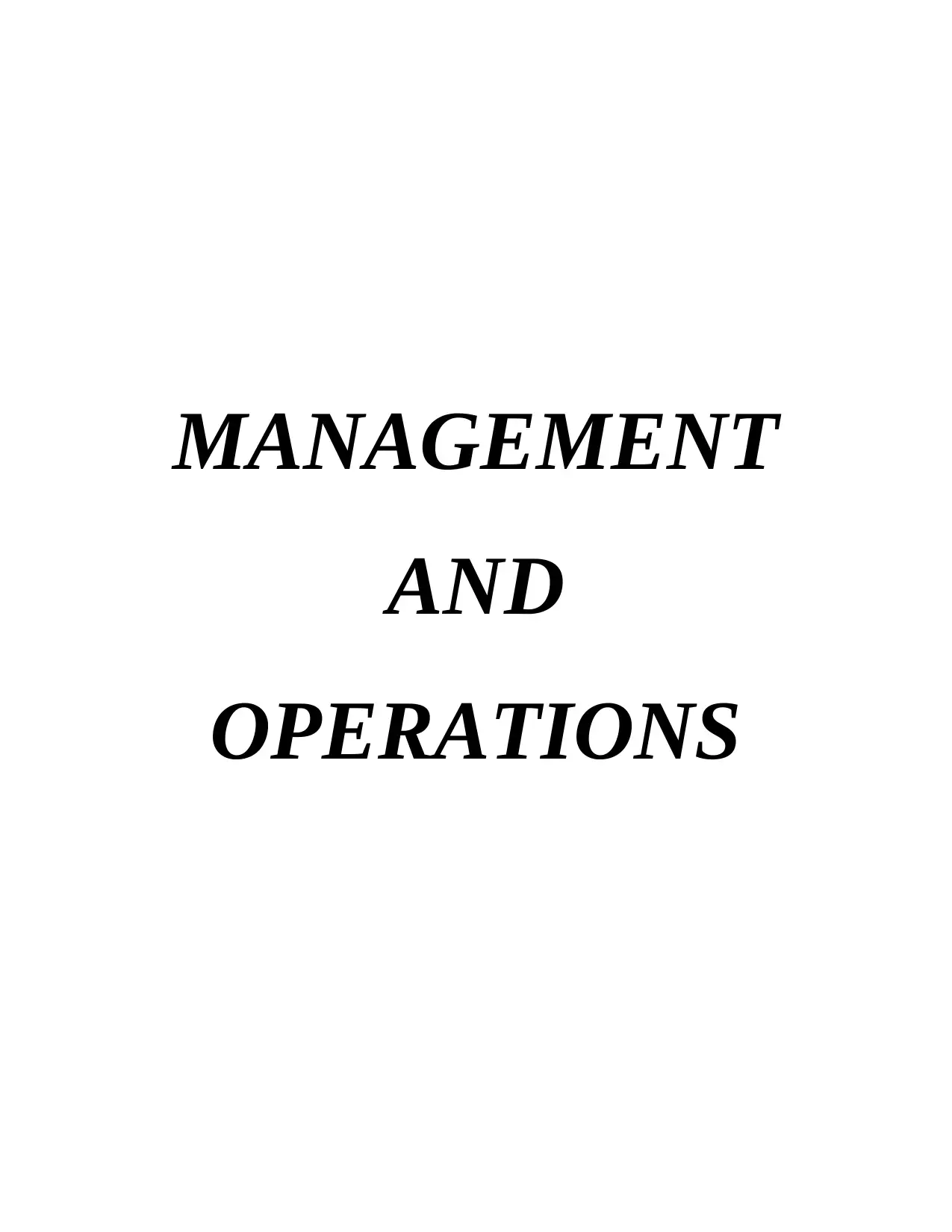
MANAGEMENT
AND
OPERATIONS
AND
OPERATIONS
Paraphrase This Document
Need a fresh take? Get an instant paraphrase of this document with our AI Paraphraser
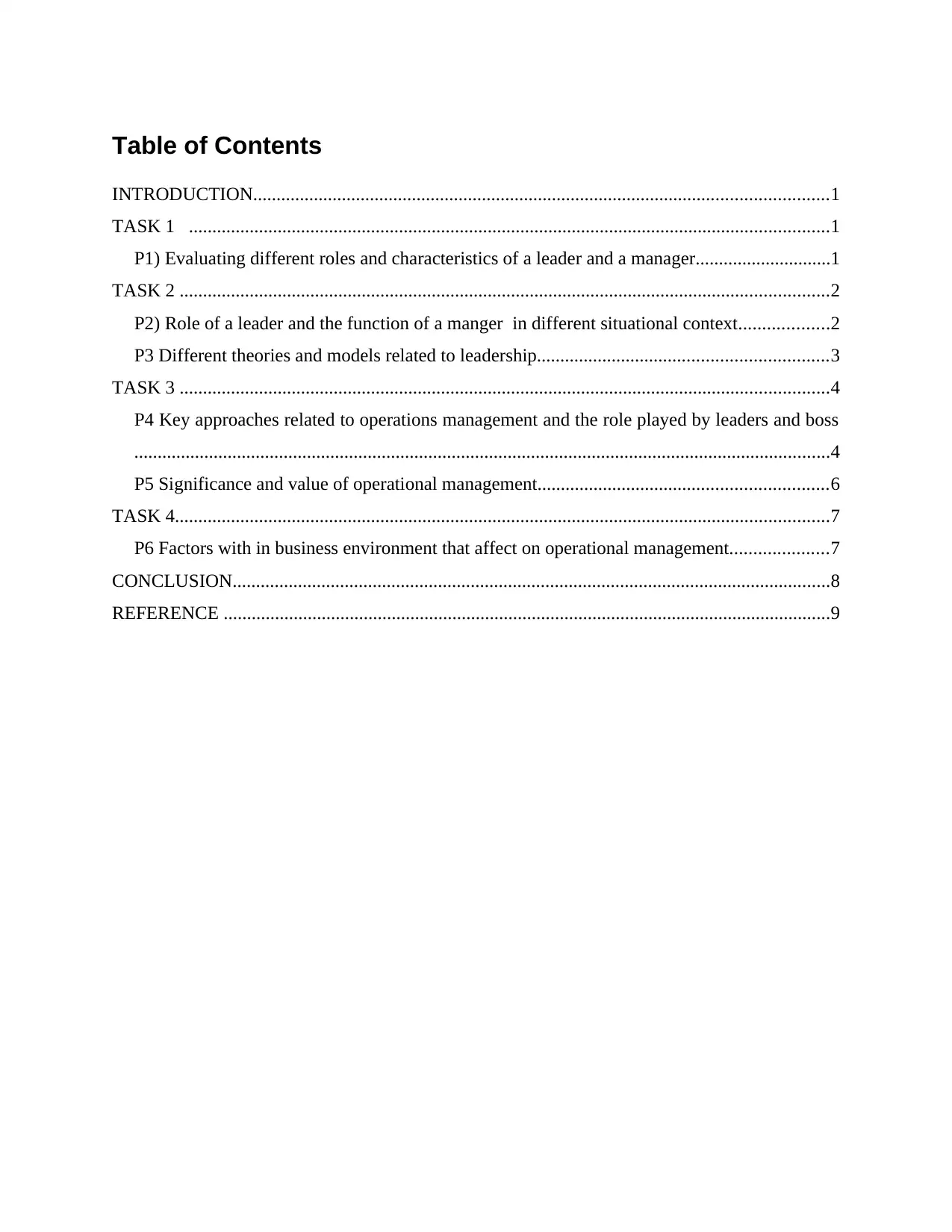
Table of Contents
INTRODUCTION...........................................................................................................................1
TASK 1 .........................................................................................................................................1
P1) Evaluating different roles and characteristics of a leader and a manager.............................1
TASK 2 ...........................................................................................................................................2
P2) Role of a leader and the function of a manger in different situational context...................2
P3 Different theories and models related to leadership..............................................................3
TASK 3 ...........................................................................................................................................4
P4 Key approaches related to operations management and the role played by leaders and boss
.....................................................................................................................................................4
P5 Significance and value of operational management..............................................................6
TASK 4............................................................................................................................................7
P6 Factors with in business environment that affect on operational management.....................7
CONCLUSION................................................................................................................................8
REFERENCE ..................................................................................................................................9
INTRODUCTION...........................................................................................................................1
TASK 1 .........................................................................................................................................1
P1) Evaluating different roles and characteristics of a leader and a manager.............................1
TASK 2 ...........................................................................................................................................2
P2) Role of a leader and the function of a manger in different situational context...................2
P3 Different theories and models related to leadership..............................................................3
TASK 3 ...........................................................................................................................................4
P4 Key approaches related to operations management and the role played by leaders and boss
.....................................................................................................................................................4
P5 Significance and value of operational management..............................................................6
TASK 4............................................................................................................................................7
P6 Factors with in business environment that affect on operational management.....................7
CONCLUSION................................................................................................................................8
REFERENCE ..................................................................................................................................9
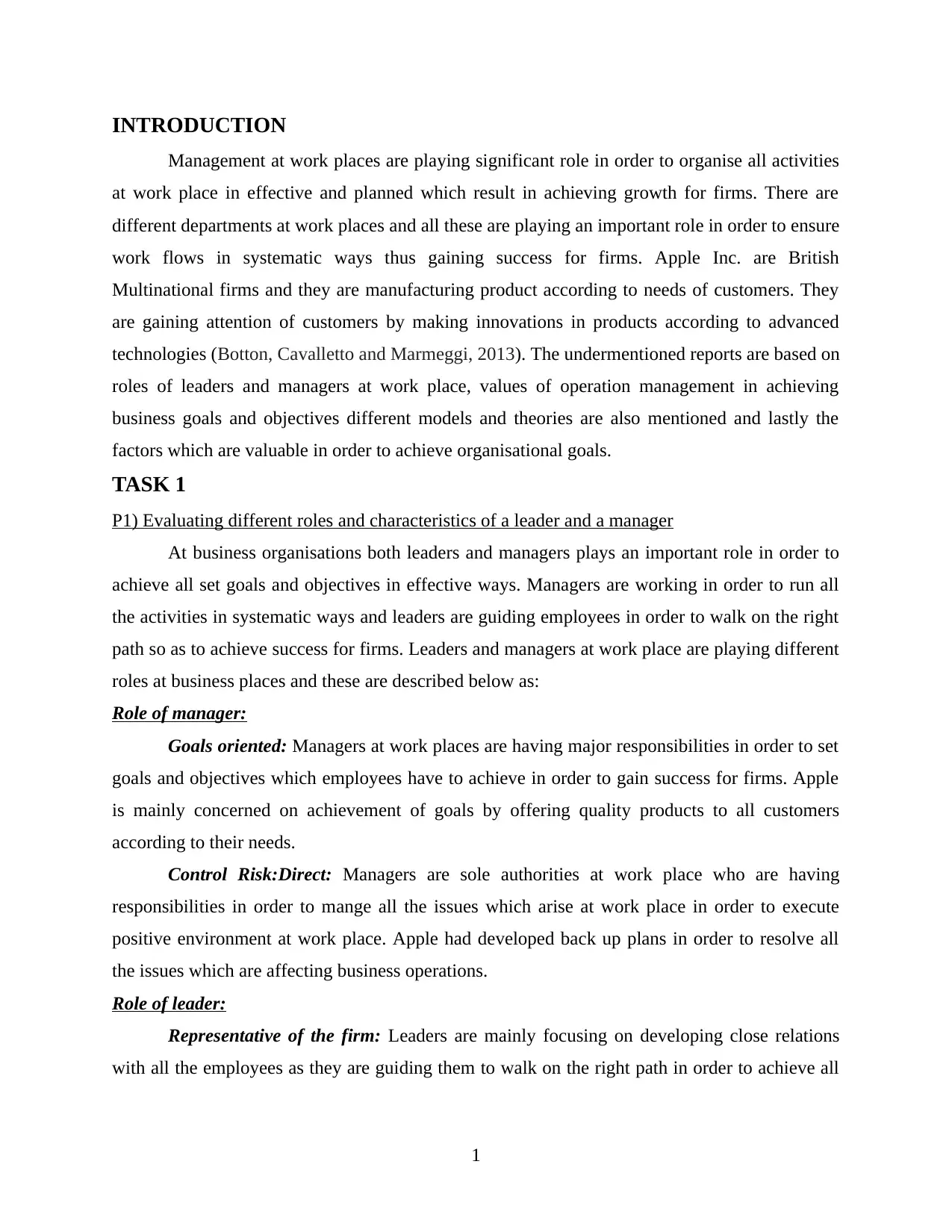
INTRODUCTION
Management at work places are playing significant role in order to organise all activities
at work place in effective and planned which result in achieving growth for firms. There are
different departments at work places and all these are playing an important role in order to ensure
work flows in systematic ways thus gaining success for firms. Apple Inc. are British
Multinational firms and they are manufacturing product according to needs of customers. They
are gaining attention of customers by making innovations in products according to advanced
technologies (Botton, Cavalletto and Marmeggi, 2013). The undermentioned reports are based on
roles of leaders and managers at work place, values of operation management in achieving
business goals and objectives different models and theories are also mentioned and lastly the
factors which are valuable in order to achieve organisational goals.
TASK 1
P1) Evaluating different roles and characteristics of a leader and a manager
At business organisations both leaders and managers plays an important role in order to
achieve all set goals and objectives in effective ways. Managers are working in order to run all
the activities in systematic ways and leaders are guiding employees in order to walk on the right
path so as to achieve success for firms. Leaders and managers at work place are playing different
roles at business places and these are described below as:
Role of manager:
Goals oriented: Managers at work places are having major responsibilities in order to set
goals and objectives which employees have to achieve in order to gain success for firms. Apple
is mainly concerned on achievement of goals by offering quality products to all customers
according to their needs.
Control Risk:Direct: Managers are sole authorities at work place who are having
responsibilities in order to mange all the issues which arise at work place in order to execute
positive environment at work place. Apple had developed back up plans in order to resolve all
the issues which are affecting business operations.
Role of leader:
Representative of the firm: Leaders are mainly focusing on developing close relations
with all the employees as they are guiding them to walk on the right path in order to achieve all
1
Management at work places are playing significant role in order to organise all activities
at work place in effective and planned which result in achieving growth for firms. There are
different departments at work places and all these are playing an important role in order to ensure
work flows in systematic ways thus gaining success for firms. Apple Inc. are British
Multinational firms and they are manufacturing product according to needs of customers. They
are gaining attention of customers by making innovations in products according to advanced
technologies (Botton, Cavalletto and Marmeggi, 2013). The undermentioned reports are based on
roles of leaders and managers at work place, values of operation management in achieving
business goals and objectives different models and theories are also mentioned and lastly the
factors which are valuable in order to achieve organisational goals.
TASK 1
P1) Evaluating different roles and characteristics of a leader and a manager
At business organisations both leaders and managers plays an important role in order to
achieve all set goals and objectives in effective ways. Managers are working in order to run all
the activities in systematic ways and leaders are guiding employees in order to walk on the right
path so as to achieve success for firms. Leaders and managers at work place are playing different
roles at business places and these are described below as:
Role of manager:
Goals oriented: Managers at work places are having major responsibilities in order to set
goals and objectives which employees have to achieve in order to gain success for firms. Apple
is mainly concerned on achievement of goals by offering quality products to all customers
according to their needs.
Control Risk:Direct: Managers are sole authorities at work place who are having
responsibilities in order to mange all the issues which arise at work place in order to execute
positive environment at work place. Apple had developed back up plans in order to resolve all
the issues which are affecting business operations.
Role of leader:
Representative of the firm: Leaders are mainly focusing on developing close relations
with all the employees as they are guiding them to walk on the right path in order to achieve all
1
⊘ This is a preview!⊘
Do you want full access?
Subscribe today to unlock all pages.

Trusted by 1+ million students worldwide
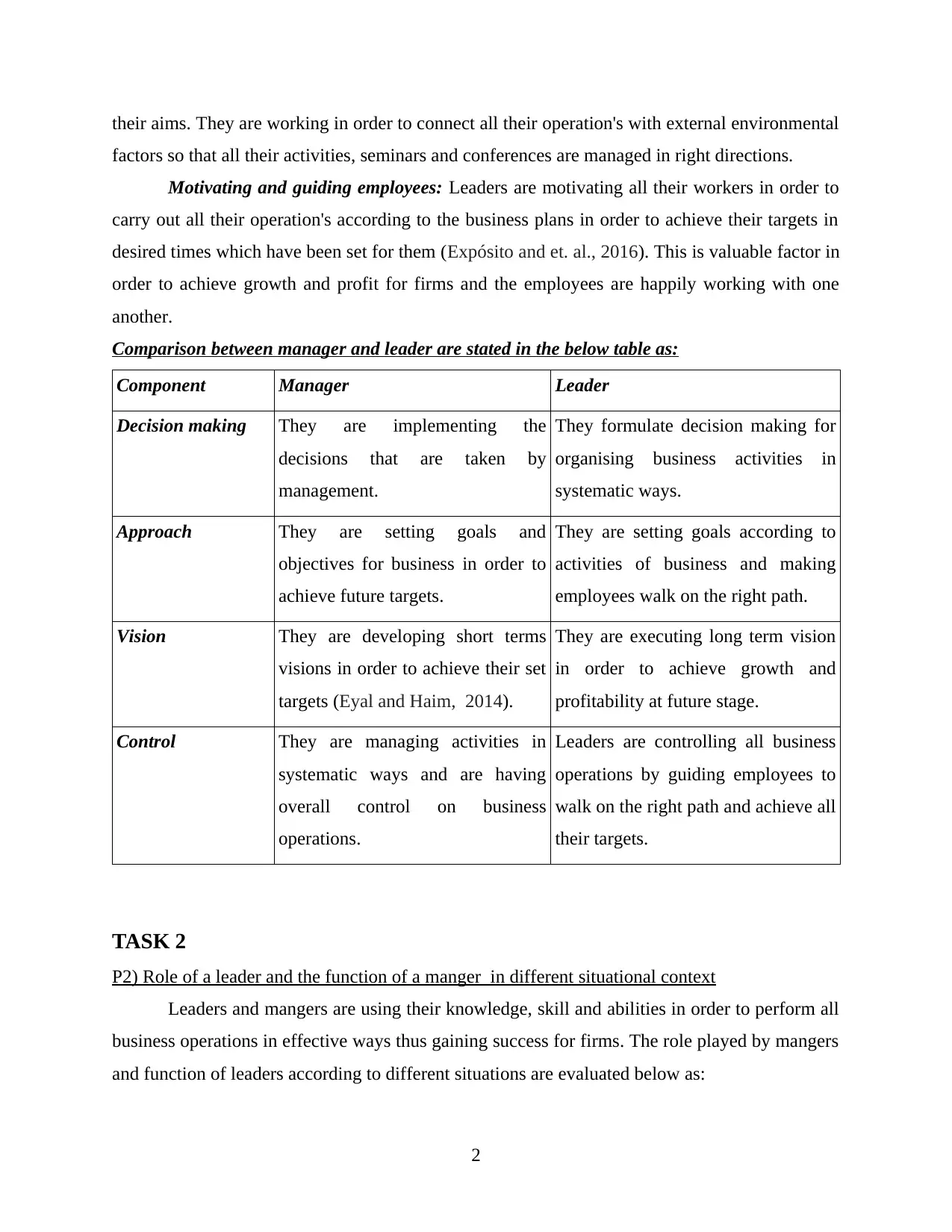
their aims. They are working in order to connect all their operation's with external environmental
factors so that all their activities, seminars and conferences are managed in right directions.
Motivating and guiding employees: Leaders are motivating all their workers in order to
carry out all their operation's according to the business plans in order to achieve their targets in
desired times which have been set for them (Expósito and et. al., 2016). This is valuable factor in
order to achieve growth and profit for firms and the employees are happily working with one
another.
Comparison between manager and leader are stated in the below table as:
Component Manager Leader
Decision making They are implementing the
decisions that are taken by
management.
They formulate decision making for
organising business activities in
systematic ways.
Approach They are setting goals and
objectives for business in order to
achieve future targets.
They are setting goals according to
activities of business and making
employees walk on the right path.
Vision They are developing short terms
visions in order to achieve their set
targets (Eyal and Haim, 2014).
They are executing long term vision
in order to achieve growth and
profitability at future stage.
Control They are managing activities in
systematic ways and are having
overall control on business
operations.
Leaders are controlling all business
operations by guiding employees to
walk on the right path and achieve all
their targets.
TASK 2
P2) Role of a leader and the function of a manger in different situational context
Leaders and mangers are using their knowledge, skill and abilities in order to perform all
business operations in effective ways thus gaining success for firms. The role played by mangers
and function of leaders according to different situations are evaluated below as:
2
factors so that all their activities, seminars and conferences are managed in right directions.
Motivating and guiding employees: Leaders are motivating all their workers in order to
carry out all their operation's according to the business plans in order to achieve their targets in
desired times which have been set for them (Expósito and et. al., 2016). This is valuable factor in
order to achieve growth and profit for firms and the employees are happily working with one
another.
Comparison between manager and leader are stated in the below table as:
Component Manager Leader
Decision making They are implementing the
decisions that are taken by
management.
They formulate decision making for
organising business activities in
systematic ways.
Approach They are setting goals and
objectives for business in order to
achieve future targets.
They are setting goals according to
activities of business and making
employees walk on the right path.
Vision They are developing short terms
visions in order to achieve their set
targets (Eyal and Haim, 2014).
They are executing long term vision
in order to achieve growth and
profitability at future stage.
Control They are managing activities in
systematic ways and are having
overall control on business
operations.
Leaders are controlling all business
operations by guiding employees to
walk on the right path and achieve all
their targets.
TASK 2
P2) Role of a leader and the function of a manger in different situational context
Leaders and mangers are using their knowledge, skill and abilities in order to perform all
business operations in effective ways thus gaining success for firms. The role played by mangers
and function of leaders according to different situations are evaluated below as:
2
Paraphrase This Document
Need a fresh take? Get an instant paraphrase of this document with our AI Paraphraser
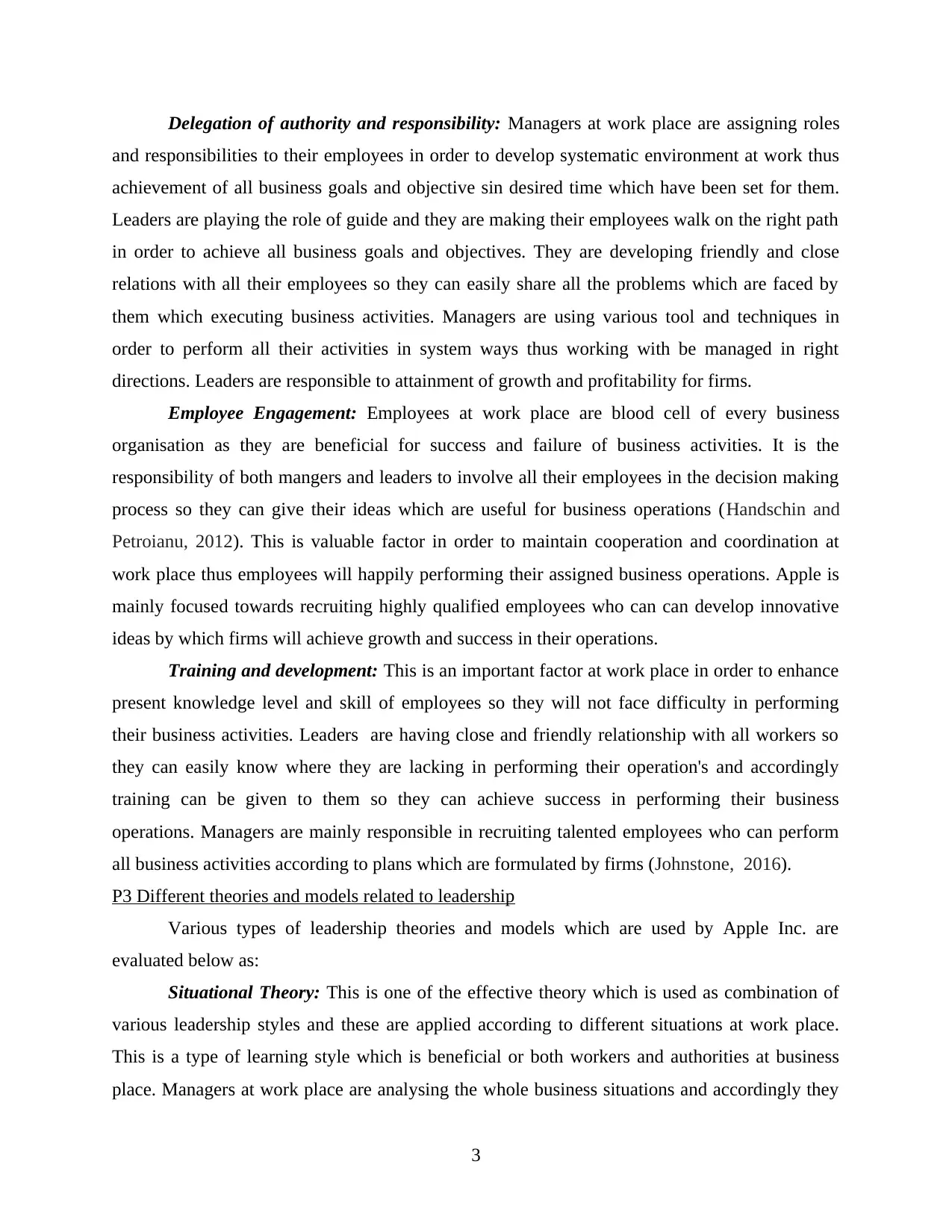
Delegation of authority and responsibility: Managers at work place are assigning roles
and responsibilities to their employees in order to develop systematic environment at work thus
achievement of all business goals and objective sin desired time which have been set for them.
Leaders are playing the role of guide and they are making their employees walk on the right path
in order to achieve all business goals and objectives. They are developing friendly and close
relations with all their employees so they can easily share all the problems which are faced by
them which executing business activities. Managers are using various tool and techniques in
order to perform all their activities in system ways thus working with be managed in right
directions. Leaders are responsible to attainment of growth and profitability for firms.
Employee Engagement: Employees at work place are blood cell of every business
organisation as they are beneficial for success and failure of business activities. It is the
responsibility of both mangers and leaders to involve all their employees in the decision making
process so they can give their ideas which are useful for business operations (Handschin and
Petroianu, 2012). This is valuable factor in order to maintain cooperation and coordination at
work place thus employees will happily performing their assigned business operations. Apple is
mainly focused towards recruiting highly qualified employees who can can develop innovative
ideas by which firms will achieve growth and success in their operations.
Training and development: This is an important factor at work place in order to enhance
present knowledge level and skill of employees so they will not face difficulty in performing
their business activities. Leaders are having close and friendly relationship with all workers so
they can easily know where they are lacking in performing their operation's and accordingly
training can be given to them so they can achieve success in performing their business
operations. Managers are mainly responsible in recruiting talented employees who can perform
all business activities according to plans which are formulated by firms (Johnstone, 2016).
P3 Different theories and models related to leadership
Various types of leadership theories and models which are used by Apple Inc. are
evaluated below as:
Situational Theory: This is one of the effective theory which is used as combination of
various leadership styles and these are applied according to different situations at work place.
This is a type of learning style which is beneficial or both workers and authorities at business
place. Managers at work place are analysing the whole business situations and accordingly they
3
and responsibilities to their employees in order to develop systematic environment at work thus
achievement of all business goals and objective sin desired time which have been set for them.
Leaders are playing the role of guide and they are making their employees walk on the right path
in order to achieve all business goals and objectives. They are developing friendly and close
relations with all their employees so they can easily share all the problems which are faced by
them which executing business activities. Managers are using various tool and techniques in
order to perform all their activities in system ways thus working with be managed in right
directions. Leaders are responsible to attainment of growth and profitability for firms.
Employee Engagement: Employees at work place are blood cell of every business
organisation as they are beneficial for success and failure of business activities. It is the
responsibility of both mangers and leaders to involve all their employees in the decision making
process so they can give their ideas which are useful for business operations (Handschin and
Petroianu, 2012). This is valuable factor in order to maintain cooperation and coordination at
work place thus employees will happily performing their assigned business operations. Apple is
mainly focused towards recruiting highly qualified employees who can can develop innovative
ideas by which firms will achieve growth and success in their operations.
Training and development: This is an important factor at work place in order to enhance
present knowledge level and skill of employees so they will not face difficulty in performing
their business activities. Leaders are having close and friendly relationship with all workers so
they can easily know where they are lacking in performing their operation's and accordingly
training can be given to them so they can achieve success in performing their business
operations. Managers are mainly responsible in recruiting talented employees who can perform
all business activities according to plans which are formulated by firms (Johnstone, 2016).
P3 Different theories and models related to leadership
Various types of leadership theories and models which are used by Apple Inc. are
evaluated below as:
Situational Theory: This is one of the effective theory which is used as combination of
various leadership styles and these are applied according to different situations at work place.
This is a type of learning style which is beneficial or both workers and authorities at business
place. Managers at work place are analysing the whole business situations and accordingly they
3
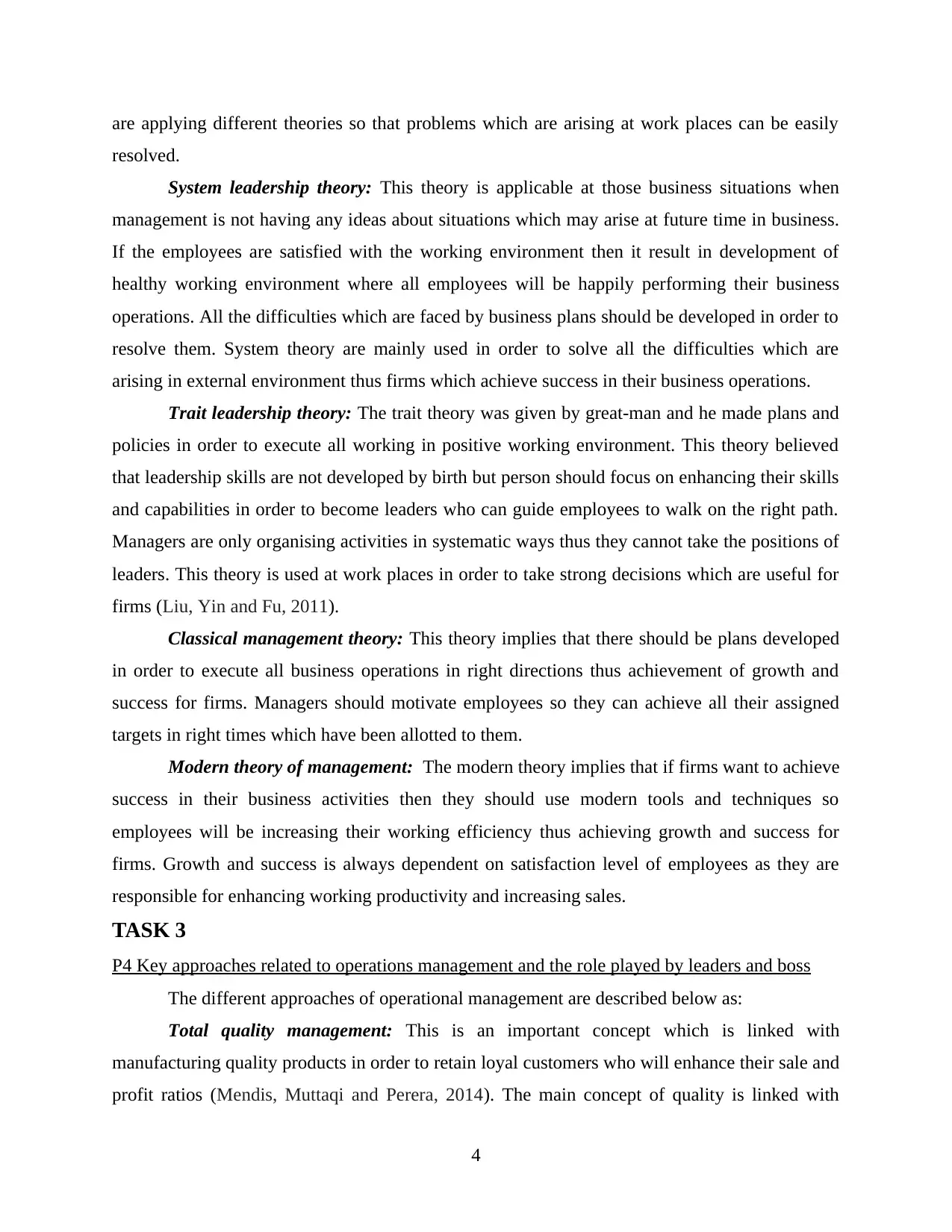
are applying different theories so that problems which are arising at work places can be easily
resolved.
System leadership theory: This theory is applicable at those business situations when
management is not having any ideas about situations which may arise at future time in business.
If the employees are satisfied with the working environment then it result in development of
healthy working environment where all employees will be happily performing their business
operations. All the difficulties which are faced by business plans should be developed in order to
resolve them. System theory are mainly used in order to solve all the difficulties which are
arising in external environment thus firms which achieve success in their business operations.
Trait leadership theory: The trait theory was given by great-man and he made plans and
policies in order to execute all working in positive working environment. This theory believed
that leadership skills are not developed by birth but person should focus on enhancing their skills
and capabilities in order to become leaders who can guide employees to walk on the right path.
Managers are only organising activities in systematic ways thus they cannot take the positions of
leaders. This theory is used at work places in order to take strong decisions which are useful for
firms (Liu, Yin and Fu, 2011).
Classical management theory: This theory implies that there should be plans developed
in order to execute all business operations in right directions thus achievement of growth and
success for firms. Managers should motivate employees so they can achieve all their assigned
targets in right times which have been allotted to them.
Modern theory of management: The modern theory implies that if firms want to achieve
success in their business activities then they should use modern tools and techniques so
employees will be increasing their working efficiency thus achieving growth and success for
firms. Growth and success is always dependent on satisfaction level of employees as they are
responsible for enhancing working productivity and increasing sales.
TASK 3
P4 Key approaches related to operations management and the role played by leaders and boss
The different approaches of operational management are described below as:
Total quality management: This is an important concept which is linked with
manufacturing quality products in order to retain loyal customers who will enhance their sale and
profit ratios (Mendis, Muttaqi and Perera, 2014). The main concept of quality is linked with
4
resolved.
System leadership theory: This theory is applicable at those business situations when
management is not having any ideas about situations which may arise at future time in business.
If the employees are satisfied with the working environment then it result in development of
healthy working environment where all employees will be happily performing their business
operations. All the difficulties which are faced by business plans should be developed in order to
resolve them. System theory are mainly used in order to solve all the difficulties which are
arising in external environment thus firms which achieve success in their business operations.
Trait leadership theory: The trait theory was given by great-man and he made plans and
policies in order to execute all working in positive working environment. This theory believed
that leadership skills are not developed by birth but person should focus on enhancing their skills
and capabilities in order to become leaders who can guide employees to walk on the right path.
Managers are only organising activities in systematic ways thus they cannot take the positions of
leaders. This theory is used at work places in order to take strong decisions which are useful for
firms (Liu, Yin and Fu, 2011).
Classical management theory: This theory implies that there should be plans developed
in order to execute all business operations in right directions thus achievement of growth and
success for firms. Managers should motivate employees so they can achieve all their assigned
targets in right times which have been allotted to them.
Modern theory of management: The modern theory implies that if firms want to achieve
success in their business activities then they should use modern tools and techniques so
employees will be increasing their working efficiency thus achieving growth and success for
firms. Growth and success is always dependent on satisfaction level of employees as they are
responsible for enhancing working productivity and increasing sales.
TASK 3
P4 Key approaches related to operations management and the role played by leaders and boss
The different approaches of operational management are described below as:
Total quality management: This is an important concept which is linked with
manufacturing quality products in order to retain loyal customers who will enhance their sale and
profit ratios (Mendis, Muttaqi and Perera, 2014). The main concept of quality is linked with
4
⊘ This is a preview!⊘
Do you want full access?
Subscribe today to unlock all pages.

Trusted by 1+ million students worldwide
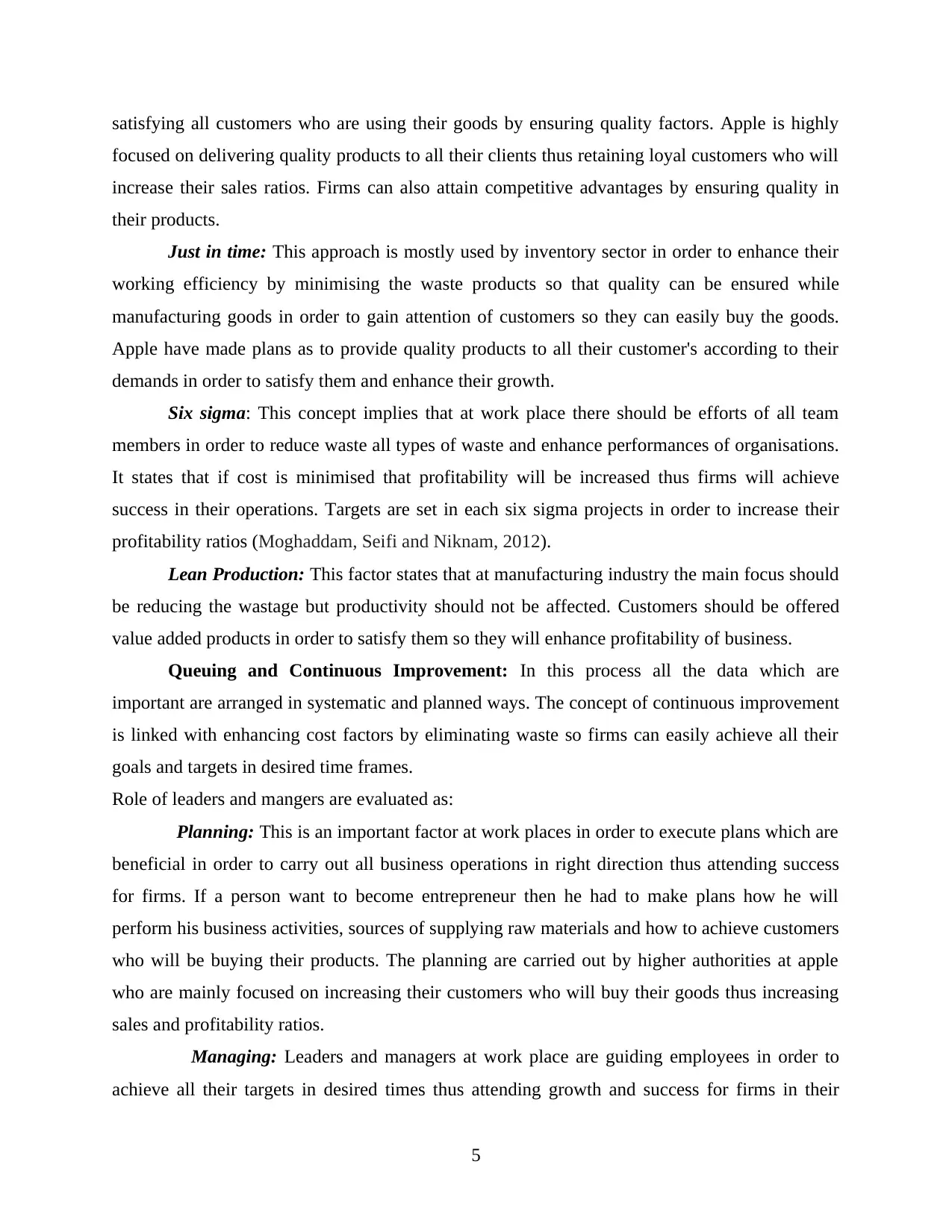
satisfying all customers who are using their goods by ensuring quality factors. Apple is highly
focused on delivering quality products to all their clients thus retaining loyal customers who will
increase their sales ratios. Firms can also attain competitive advantages by ensuring quality in
their products.
Just in time: This approach is mostly used by inventory sector in order to enhance their
working efficiency by minimising the waste products so that quality can be ensured while
manufacturing goods in order to gain attention of customers so they can easily buy the goods.
Apple have made plans as to provide quality products to all their customer's according to their
demands in order to satisfy them and enhance their growth.
Six sigma: This concept implies that at work place there should be efforts of all team
members in order to reduce waste all types of waste and enhance performances of organisations.
It states that if cost is minimised that profitability will be increased thus firms will achieve
success in their operations. Targets are set in each six sigma projects in order to increase their
profitability ratios (Moghaddam, Seifi and Niknam, 2012).
Lean Production: This factor states that at manufacturing industry the main focus should
be reducing the wastage but productivity should not be affected. Customers should be offered
value added products in order to satisfy them so they will enhance profitability of business.
Queuing and Continuous Improvement: In this process all the data which are
important are arranged in systematic and planned ways. The concept of continuous improvement
is linked with enhancing cost factors by eliminating waste so firms can easily achieve all their
goals and targets in desired time frames.
Role of leaders and mangers are evaluated as:
Planning: This is an important factor at work places in order to execute plans which are
beneficial in order to carry out all business operations in right direction thus attending success
for firms. If a person want to become entrepreneur then he had to make plans how he will
perform his business activities, sources of supplying raw materials and how to achieve customers
who will be buying their products. The planning are carried out by higher authorities at apple
who are mainly focused on increasing their customers who will buy their goods thus increasing
sales and profitability ratios.
Managing: Leaders and managers at work place are guiding employees in order to
achieve all their targets in desired times thus attending growth and success for firms in their
5
focused on delivering quality products to all their clients thus retaining loyal customers who will
increase their sales ratios. Firms can also attain competitive advantages by ensuring quality in
their products.
Just in time: This approach is mostly used by inventory sector in order to enhance their
working efficiency by minimising the waste products so that quality can be ensured while
manufacturing goods in order to gain attention of customers so they can easily buy the goods.
Apple have made plans as to provide quality products to all their customer's according to their
demands in order to satisfy them and enhance their growth.
Six sigma: This concept implies that at work place there should be efforts of all team
members in order to reduce waste all types of waste and enhance performances of organisations.
It states that if cost is minimised that profitability will be increased thus firms will achieve
success in their operations. Targets are set in each six sigma projects in order to increase their
profitability ratios (Moghaddam, Seifi and Niknam, 2012).
Lean Production: This factor states that at manufacturing industry the main focus should
be reducing the wastage but productivity should not be affected. Customers should be offered
value added products in order to satisfy them so they will enhance profitability of business.
Queuing and Continuous Improvement: In this process all the data which are
important are arranged in systematic and planned ways. The concept of continuous improvement
is linked with enhancing cost factors by eliminating waste so firms can easily achieve all their
goals and targets in desired time frames.
Role of leaders and mangers are evaluated as:
Planning: This is an important factor at work places in order to execute plans which are
beneficial in order to carry out all business operations in right direction thus attending success
for firms. If a person want to become entrepreneur then he had to make plans how he will
perform his business activities, sources of supplying raw materials and how to achieve customers
who will be buying their products. The planning are carried out by higher authorities at apple
who are mainly focused on increasing their customers who will buy their goods thus increasing
sales and profitability ratios.
Managing: Leaders and managers at work place are guiding employees in order to
achieve all their targets in desired times thus attending growth and success for firms in their
5
Paraphrase This Document
Need a fresh take? Get an instant paraphrase of this document with our AI Paraphraser
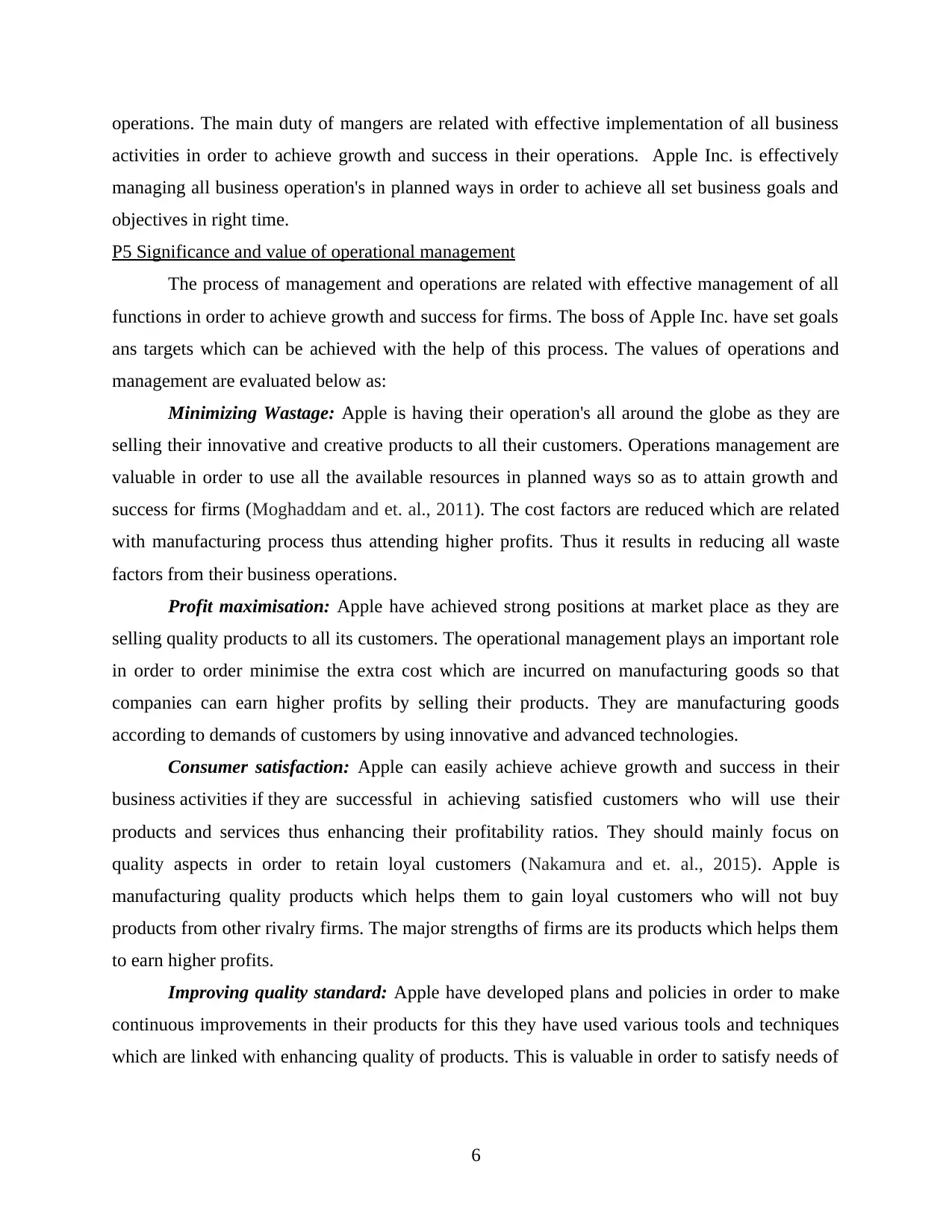
operations. The main duty of mangers are related with effective implementation of all business
activities in order to achieve growth and success in their operations. Apple Inc. is effectively
managing all business operation's in planned ways in order to achieve all set business goals and
objectives in right time.
P5 Significance and value of operational management
The process of management and operations are related with effective management of all
functions in order to achieve growth and success for firms. The boss of Apple Inc. have set goals
ans targets which can be achieved with the help of this process. The values of operations and
management are evaluated below as:
Minimizing Wastage: Apple is having their operation's all around the globe as they are
selling their innovative and creative products to all their customers. Operations management are
valuable in order to use all the available resources in planned ways so as to attain growth and
success for firms (Moghaddam and et. al., 2011). The cost factors are reduced which are related
with manufacturing process thus attending higher profits. Thus it results in reducing all waste
factors from their business operations.
Profit maximisation: Apple have achieved strong positions at market place as they are
selling quality products to all its customers. The operational management plays an important role
in order to order minimise the extra cost which are incurred on manufacturing goods so that
companies can earn higher profits by selling their products. They are manufacturing goods
according to demands of customers by using innovative and advanced technologies.
Consumer satisfaction: Apple can easily achieve achieve growth and success in their
business activities if they are successful in achieving satisfied customers who will use their
products and services thus enhancing their profitability ratios. They should mainly focus on
quality aspects in order to retain loyal customers (Nakamura and et. al., 2015). Apple is
manufacturing quality products which helps them to gain loyal customers who will not buy
products from other rivalry firms. The major strengths of firms are its products which helps them
to earn higher profits.
Improving quality standard: Apple have developed plans and policies in order to make
continuous improvements in their products for this they have used various tools and techniques
which are linked with enhancing quality of products. This is valuable in order to satisfy needs of
6
activities in order to achieve growth and success in their operations. Apple Inc. is effectively
managing all business operation's in planned ways in order to achieve all set business goals and
objectives in right time.
P5 Significance and value of operational management
The process of management and operations are related with effective management of all
functions in order to achieve growth and success for firms. The boss of Apple Inc. have set goals
ans targets which can be achieved with the help of this process. The values of operations and
management are evaluated below as:
Minimizing Wastage: Apple is having their operation's all around the globe as they are
selling their innovative and creative products to all their customers. Operations management are
valuable in order to use all the available resources in planned ways so as to attain growth and
success for firms (Moghaddam and et. al., 2011). The cost factors are reduced which are related
with manufacturing process thus attending higher profits. Thus it results in reducing all waste
factors from their business operations.
Profit maximisation: Apple have achieved strong positions at market place as they are
selling quality products to all its customers. The operational management plays an important role
in order to order minimise the extra cost which are incurred on manufacturing goods so that
companies can earn higher profits by selling their products. They are manufacturing goods
according to demands of customers by using innovative and advanced technologies.
Consumer satisfaction: Apple can easily achieve achieve growth and success in their
business activities if they are successful in achieving satisfied customers who will use their
products and services thus enhancing their profitability ratios. They should mainly focus on
quality aspects in order to retain loyal customers (Nakamura and et. al., 2015). Apple is
manufacturing quality products which helps them to gain loyal customers who will not buy
products from other rivalry firms. The major strengths of firms are its products which helps them
to earn higher profits.
Improving quality standard: Apple have developed plans and policies in order to make
continuous improvements in their products for this they have used various tools and techniques
which are linked with enhancing quality of products. This is valuable in order to satisfy needs of
6
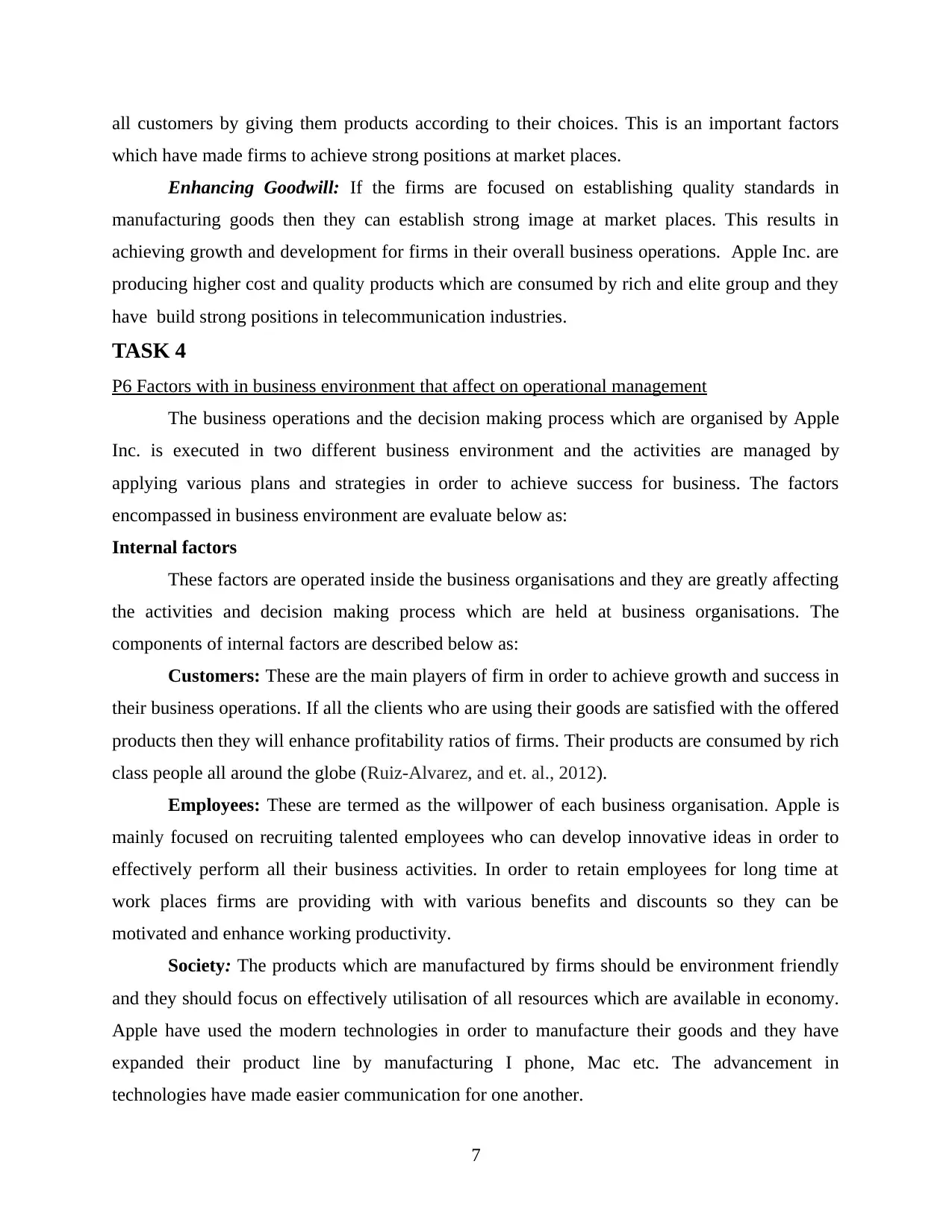
all customers by giving them products according to their choices. This is an important factors
which have made firms to achieve strong positions at market places.
Enhancing Goodwill: If the firms are focused on establishing quality standards in
manufacturing goods then they can establish strong image at market places. This results in
achieving growth and development for firms in their overall business operations. Apple Inc. are
producing higher cost and quality products which are consumed by rich and elite group and they
have build strong positions in telecommunication industries.
TASK 4
P6 Factors with in business environment that affect on operational management
The business operations and the decision making process which are organised by Apple
Inc. is executed in two different business environment and the activities are managed by
applying various plans and strategies in order to achieve success for business. The factors
encompassed in business environment are evaluate below as:
Internal factors
These factors are operated inside the business organisations and they are greatly affecting
the activities and decision making process which are held at business organisations. The
components of internal factors are described below as:
Customers: These are the main players of firm in order to achieve growth and success in
their business operations. If all the clients who are using their goods are satisfied with the offered
products then they will enhance profitability ratios of firms. Their products are consumed by rich
class people all around the globe (Ruiz-Alvarez, and et. al., 2012).
Employees: These are termed as the willpower of each business organisation. Apple is
mainly focused on recruiting talented employees who can develop innovative ideas in order to
effectively perform all their business activities. In order to retain employees for long time at
work places firms are providing with with various benefits and discounts so they can be
motivated and enhance working productivity.
Society: The products which are manufactured by firms should be environment friendly
and they should focus on effectively utilisation of all resources which are available in economy.
Apple have used the modern technologies in order to manufacture their goods and they have
expanded their product line by manufacturing I phone, Mac etc. The advancement in
technologies have made easier communication for one another.
7
which have made firms to achieve strong positions at market places.
Enhancing Goodwill: If the firms are focused on establishing quality standards in
manufacturing goods then they can establish strong image at market places. This results in
achieving growth and development for firms in their overall business operations. Apple Inc. are
producing higher cost and quality products which are consumed by rich and elite group and they
have build strong positions in telecommunication industries.
TASK 4
P6 Factors with in business environment that affect on operational management
The business operations and the decision making process which are organised by Apple
Inc. is executed in two different business environment and the activities are managed by
applying various plans and strategies in order to achieve success for business. The factors
encompassed in business environment are evaluate below as:
Internal factors
These factors are operated inside the business organisations and they are greatly affecting
the activities and decision making process which are held at business organisations. The
components of internal factors are described below as:
Customers: These are the main players of firm in order to achieve growth and success in
their business operations. If all the clients who are using their goods are satisfied with the offered
products then they will enhance profitability ratios of firms. Their products are consumed by rich
class people all around the globe (Ruiz-Alvarez, and et. al., 2012).
Employees: These are termed as the willpower of each business organisation. Apple is
mainly focused on recruiting talented employees who can develop innovative ideas in order to
effectively perform all their business activities. In order to retain employees for long time at
work places firms are providing with with various benefits and discounts so they can be
motivated and enhance working productivity.
Society: The products which are manufactured by firms should be environment friendly
and they should focus on effectively utilisation of all resources which are available in economy.
Apple have used the modern technologies in order to manufacture their goods and they have
expanded their product line by manufacturing I phone, Mac etc. The advancement in
technologies have made easier communication for one another.
7
⊘ This is a preview!⊘
Do you want full access?
Subscribe today to unlock all pages.

Trusted by 1+ million students worldwide
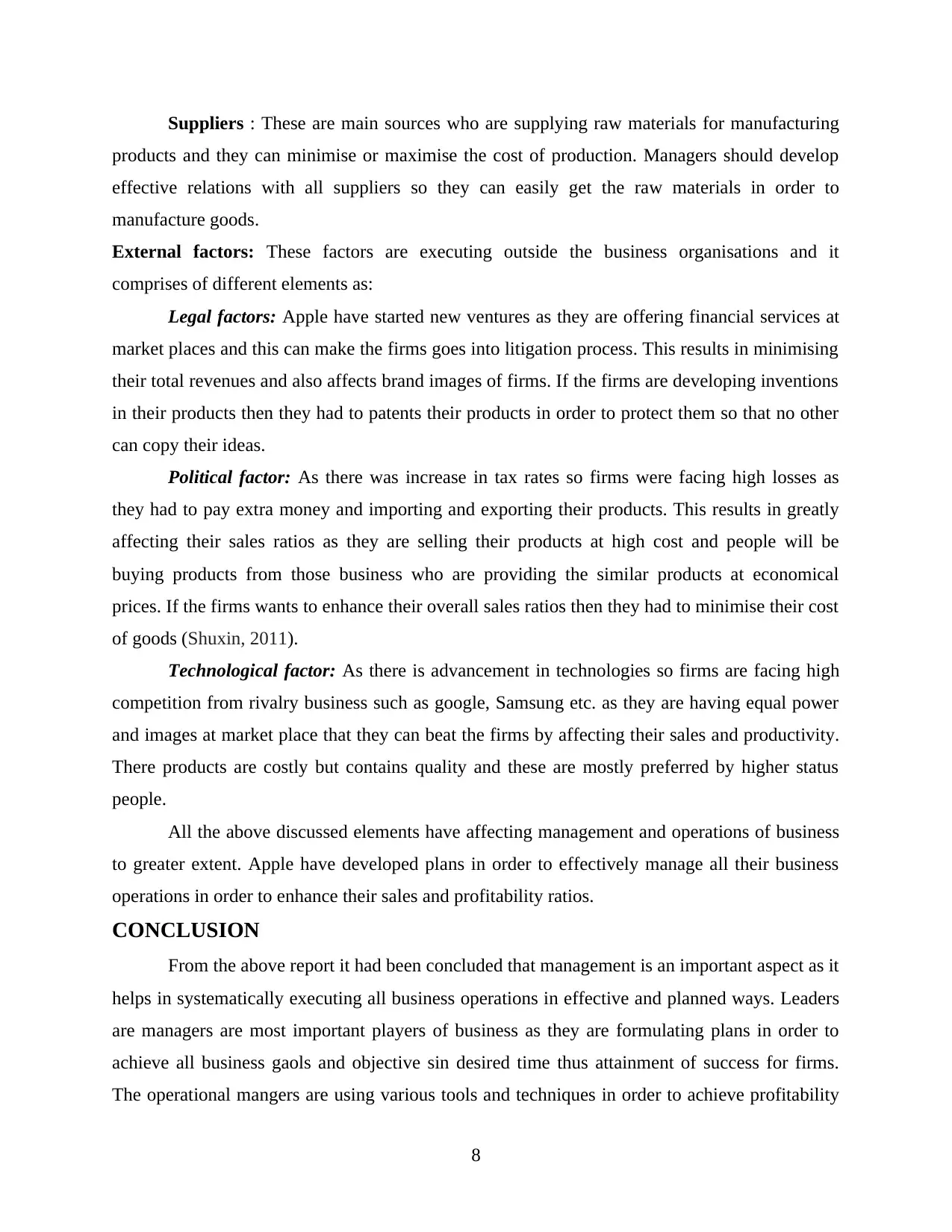
Suppliers : These are main sources who are supplying raw materials for manufacturing
products and they can minimise or maximise the cost of production. Managers should develop
effective relations with all suppliers so they can easily get the raw materials in order to
manufacture goods.
External factors: These factors are executing outside the business organisations and it
comprises of different elements as:
Legal factors: Apple have started new ventures as they are offering financial services at
market places and this can make the firms goes into litigation process. This results in minimising
their total revenues and also affects brand images of firms. If the firms are developing inventions
in their products then they had to patents their products in order to protect them so that no other
can copy their ideas.
Political factor: As there was increase in tax rates so firms were facing high losses as
they had to pay extra money and importing and exporting their products. This results in greatly
affecting their sales ratios as they are selling their products at high cost and people will be
buying products from those business who are providing the similar products at economical
prices. If the firms wants to enhance their overall sales ratios then they had to minimise their cost
of goods (Shuxin, 2011).
Technological factor: As there is advancement in technologies so firms are facing high
competition from rivalry business such as google, Samsung etc. as they are having equal power
and images at market place that they can beat the firms by affecting their sales and productivity.
There products are costly but contains quality and these are mostly preferred by higher status
people.
All the above discussed elements have affecting management and operations of business
to greater extent. Apple have developed plans in order to effectively manage all their business
operations in order to enhance their sales and profitability ratios.
CONCLUSION
From the above report it had been concluded that management is an important aspect as it
helps in systematically executing all business operations in effective and planned ways. Leaders
are managers are most important players of business as they are formulating plans in order to
achieve all business gaols and objective sin desired time thus attainment of success for firms.
The operational mangers are using various tools and techniques in order to achieve profitability
8
products and they can minimise or maximise the cost of production. Managers should develop
effective relations with all suppliers so they can easily get the raw materials in order to
manufacture goods.
External factors: These factors are executing outside the business organisations and it
comprises of different elements as:
Legal factors: Apple have started new ventures as they are offering financial services at
market places and this can make the firms goes into litigation process. This results in minimising
their total revenues and also affects brand images of firms. If the firms are developing inventions
in their products then they had to patents their products in order to protect them so that no other
can copy their ideas.
Political factor: As there was increase in tax rates so firms were facing high losses as
they had to pay extra money and importing and exporting their products. This results in greatly
affecting their sales ratios as they are selling their products at high cost and people will be
buying products from those business who are providing the similar products at economical
prices. If the firms wants to enhance their overall sales ratios then they had to minimise their cost
of goods (Shuxin, 2011).
Technological factor: As there is advancement in technologies so firms are facing high
competition from rivalry business such as google, Samsung etc. as they are having equal power
and images at market place that they can beat the firms by affecting their sales and productivity.
There products are costly but contains quality and these are mostly preferred by higher status
people.
All the above discussed elements have affecting management and operations of business
to greater extent. Apple have developed plans in order to effectively manage all their business
operations in order to enhance their sales and profitability ratios.
CONCLUSION
From the above report it had been concluded that management is an important aspect as it
helps in systematically executing all business operations in effective and planned ways. Leaders
are managers are most important players of business as they are formulating plans in order to
achieve all business gaols and objective sin desired time thus attainment of success for firms.
The operational mangers are using various tools and techniques in order to achieve profitability
8
Paraphrase This Document
Need a fresh take? Get an instant paraphrase of this document with our AI Paraphraser
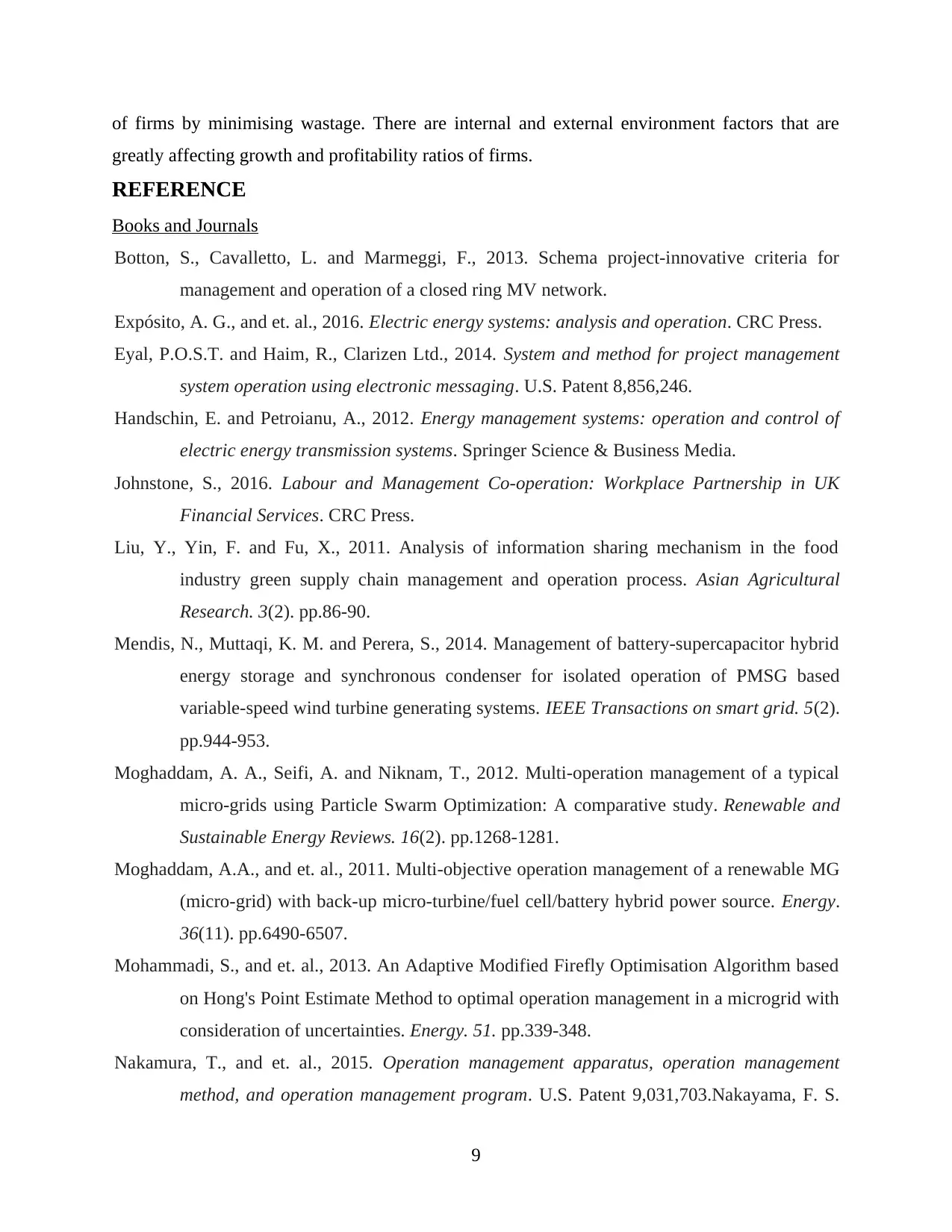
of firms by minimising wastage. There are internal and external environment factors that are
greatly affecting growth and profitability ratios of firms.
REFERENCE
Books and Journals
Botton, S., Cavalletto, L. and Marmeggi, F., 2013. Schema project-innovative criteria for
management and operation of a closed ring MV network.
Expósito, A. G., and et. al., 2016. Electric energy systems: analysis and operation. CRC Press.
Eyal, P.O.S.T. and Haim, R., Clarizen Ltd., 2014. System and method for project management
system operation using electronic messaging. U.S. Patent 8,856,246.
Handschin, E. and Petroianu, A., 2012. Energy management systems: operation and control of
electric energy transmission systems. Springer Science & Business Media.
Johnstone, S., 2016. Labour and Management Co-operation: Workplace Partnership in UK
Financial Services. CRC Press.
Liu, Y., Yin, F. and Fu, X., 2011. Analysis of information sharing mechanism in the food
industry green supply chain management and operation process. Asian Agricultural
Research. 3(2). pp.86-90.
Mendis, N., Muttaqi, K. M. and Perera, S., 2014. Management of battery-supercapacitor hybrid
energy storage and synchronous condenser for isolated operation of PMSG based
variable-speed wind turbine generating systems. IEEE Transactions on smart grid. 5(2).
pp.944-953.
Moghaddam, A. A., Seifi, A. and Niknam, T., 2012. Multi-operation management of a typical
micro-grids using Particle Swarm Optimization: A comparative study. Renewable and
Sustainable Energy Reviews. 16(2). pp.1268-1281.
Moghaddam, A.A., and et. al., 2011. Multi-objective operation management of a renewable MG
(micro-grid) with back-up micro-turbine/fuel cell/battery hybrid power source. Energy.
36(11). pp.6490-6507.
Mohammadi, S., and et. al., 2013. An Adaptive Modified Firefly Optimisation Algorithm based
on Hong's Point Estimate Method to optimal operation management in a microgrid with
consideration of uncertainties. Energy. 51. pp.339-348.
Nakamura, T., and et. al., 2015. Operation management apparatus, operation management
method, and operation management program. U.S. Patent 9,031,703.Nakayama, F. S.
9
greatly affecting growth and profitability ratios of firms.
REFERENCE
Books and Journals
Botton, S., Cavalletto, L. and Marmeggi, F., 2013. Schema project-innovative criteria for
management and operation of a closed ring MV network.
Expósito, A. G., and et. al., 2016. Electric energy systems: analysis and operation. CRC Press.
Eyal, P.O.S.T. and Haim, R., Clarizen Ltd., 2014. System and method for project management
system operation using electronic messaging. U.S. Patent 8,856,246.
Handschin, E. and Petroianu, A., 2012. Energy management systems: operation and control of
electric energy transmission systems. Springer Science & Business Media.
Johnstone, S., 2016. Labour and Management Co-operation: Workplace Partnership in UK
Financial Services. CRC Press.
Liu, Y., Yin, F. and Fu, X., 2011. Analysis of information sharing mechanism in the food
industry green supply chain management and operation process. Asian Agricultural
Research. 3(2). pp.86-90.
Mendis, N., Muttaqi, K. M. and Perera, S., 2014. Management of battery-supercapacitor hybrid
energy storage and synchronous condenser for isolated operation of PMSG based
variable-speed wind turbine generating systems. IEEE Transactions on smart grid. 5(2).
pp.944-953.
Moghaddam, A. A., Seifi, A. and Niknam, T., 2012. Multi-operation management of a typical
micro-grids using Particle Swarm Optimization: A comparative study. Renewable and
Sustainable Energy Reviews. 16(2). pp.1268-1281.
Moghaddam, A.A., and et. al., 2011. Multi-objective operation management of a renewable MG
(micro-grid) with back-up micro-turbine/fuel cell/battery hybrid power source. Energy.
36(11). pp.6490-6507.
Mohammadi, S., and et. al., 2013. An Adaptive Modified Firefly Optimisation Algorithm based
on Hong's Point Estimate Method to optimal operation management in a microgrid with
consideration of uncertainties. Energy. 51. pp.339-348.
Nakamura, T., and et. al., 2015. Operation management apparatus, operation management
method, and operation management program. U.S. Patent 9,031,703.Nakayama, F. S.
9
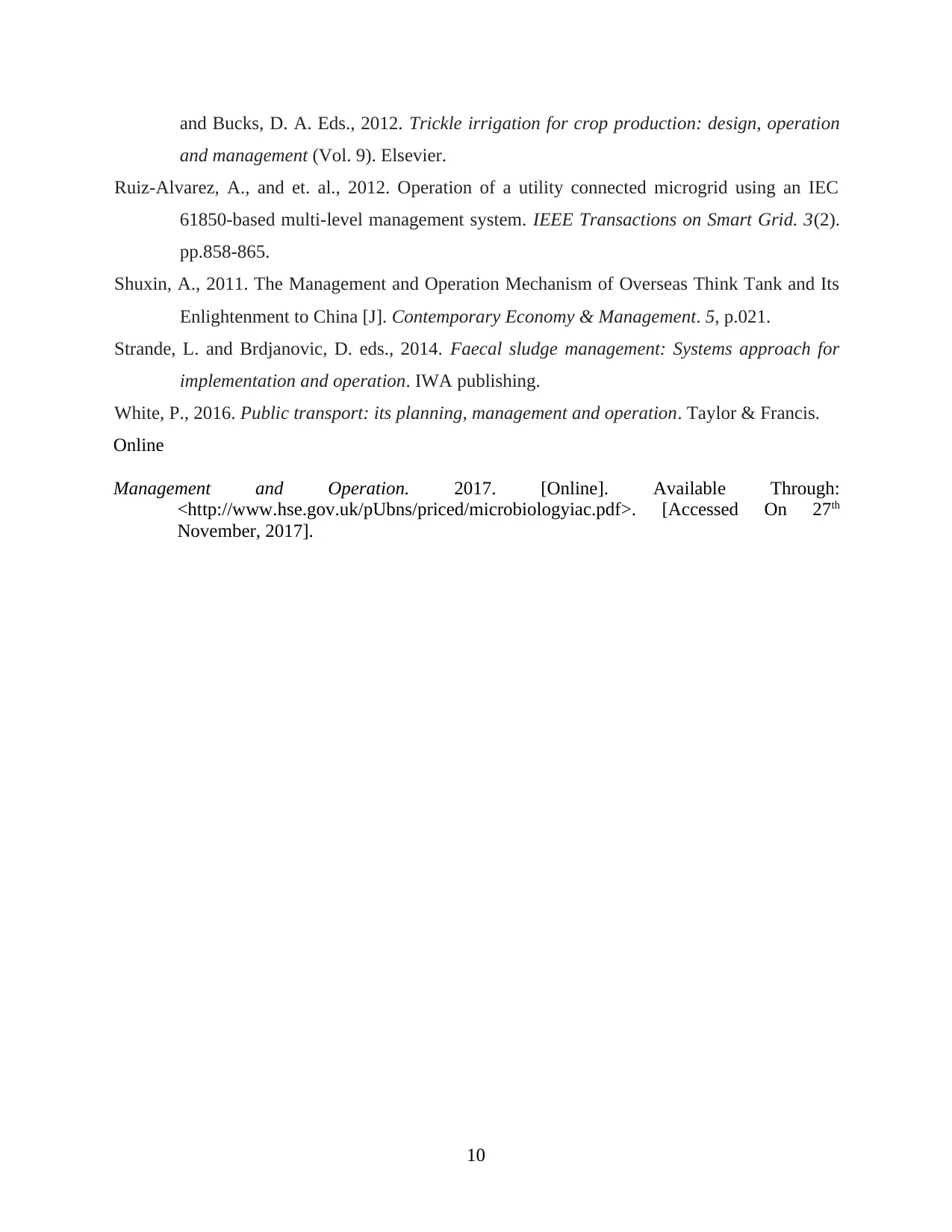
and Bucks, D. A. Eds., 2012. Trickle irrigation for crop production: design, operation
and management (Vol. 9). Elsevier.
Ruiz-Alvarez, A., and et. al., 2012. Operation of a utility connected microgrid using an IEC
61850-based multi-level management system. IEEE Transactions on Smart Grid. 3(2).
pp.858-865.
Shuxin, A., 2011. The Management and Operation Mechanism of Overseas Think Tank and Its
Enlightenment to China [J]. Contemporary Economy & Management. 5, p.021.
Strande, L. and Brdjanovic, D. eds., 2014. Faecal sludge management: Systems approach for
implementation and operation. IWA publishing.
White, P., 2016. Public transport: its planning, management and operation. Taylor & Francis.
Online
Management and Operation. 2017. [Online]. Available Through:
<http://www.hse.gov.uk/pUbns/priced/microbiologyiac.pdf>. [Accessed On 27th
November, 2017].
10
and management (Vol. 9). Elsevier.
Ruiz-Alvarez, A., and et. al., 2012. Operation of a utility connected microgrid using an IEC
61850-based multi-level management system. IEEE Transactions on Smart Grid. 3(2).
pp.858-865.
Shuxin, A., 2011. The Management and Operation Mechanism of Overseas Think Tank and Its
Enlightenment to China [J]. Contemporary Economy & Management. 5, p.021.
Strande, L. and Brdjanovic, D. eds., 2014. Faecal sludge management: Systems approach for
implementation and operation. IWA publishing.
White, P., 2016. Public transport: its planning, management and operation. Taylor & Francis.
Online
Management and Operation. 2017. [Online]. Available Through:
<http://www.hse.gov.uk/pUbns/priced/microbiologyiac.pdf>. [Accessed On 27th
November, 2017].
10
⊘ This is a preview!⊘
Do you want full access?
Subscribe today to unlock all pages.

Trusted by 1+ million students worldwide
1 out of 12
Related Documents
Your All-in-One AI-Powered Toolkit for Academic Success.
+13062052269
info@desklib.com
Available 24*7 on WhatsApp / Email
![[object Object]](/_next/static/media/star-bottom.7253800d.svg)
Unlock your academic potential
Copyright © 2020–2025 A2Z Services. All Rights Reserved. Developed and managed by ZUCOL.





